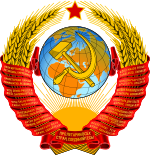Soviet of the Union
Soviet of the Union Сове́т Сою́за | |
|---|---|
| Legislative body in theSoviet Union | |
 | |
| Type | |
| Type | |
| History | |
| Established | 1938 |
| Disbanded | 11 December 1991 |
| Preceded by | Congress of Soviets |
| Succeeded by | Soviet of the Republic CIS Interparliamentary Assembly |
| Leadership | |
Konstantin Lubenchenko(last) | |
| Structure | |
 | |
Political groups | Composition after the 1984 election: Communist Party of the Soviet Union(551) Independents (199) |
| Elections | |
| Directelections(until 1989) Electedby theCongress of People's Deputies of the USSR(from 1989) | |
| Meeting place | |
 | |
| Grand Kremlin Palace,Moscow Kremlin | |
| Politics of the Soviet Union |
|---|
 |
|
|
TheSoviet of the Union(‹See Tfd›Russian:Сове́т Сою́за,Sovet Soyuza[a]) was thelowerchamberof theSupreme Sovietof theUnion of Soviet Socialist Republics,elected on the basis of universal, equal and direct suffrage in accordance with the principles ofSoviet democracy,and with the rule that each deputy would represent the same number of voters. Under the1936 Soviet Constitution,there was one deputy for every 300,000 people; this was changed by the1977 Soviet Constitution,which provided that both chambers would have an equal number of members. Although the party gave general guidelines on nominations, such as the ratio of the social composition of the nominees, much of the work was left to local bodies and people's representatives.[1]As opposed to theupper chamber,theSoviet of Nationalities,the Soviet of the Union represented the interests of all of the people of the Soviet Union no matter what their nationality was.
The Soviet of the Union had the same rights andcompetenceas the Soviet of Nationalities, including the right forlegislative initiative.In practice, until 1989, it did little more than approve decisions already made by the top leadership of theCommunist Party of the Soviet Union.[citation needed]After the1989 elections–the first, and as it turned out, only, free elections ever held in the Soviet Union–the Soviet of the Union acquired a much greater role, and was the scene of many lively debates.
The Soviet of the Union elected achairman(who would lead the sessions of the chamber), his four deputies and permanentcommissions:Mandates, Legislative Proposals,BudgetPlanning,Foreign Affairs,Youth Affairs, Industry, Transportation and Communications, Construction and Industry ofBuilding Materials,Agriculture,Consumer goods,Public Education,HealthcareandSocial Security,ScienceandCulture,Trade,Consumer Service and Municipal Economy,Environment.
In 1989, it was reduced to 271 deputies, elected by theCongress of People's Deputies.Its deputies were elected representing territorial electoral districts and public organizations, taking into account the size of the electorate in a Union Republic or region. In 1991, after theAugust Coup,it was renamed the Soviet (Council) of the Union, with its deputies apportioned by the existing quotas and in coordination with the bodies of power in the Union Republics. It would consider only issues concerning civil rights and other issues that didn't fall under theSoviet of Nationalities.Its decisions would have to be reviewed by the Soviet of Nationalities.
The Soviet of the Union was effectively dissolved on 12 December 1991, two weeks before the formaldissolution of the Soviet Union,when theRussian Soviet Federative Socialist Republicrecalled its deputies, leaving it without a quorum. The legality of this action was questionable, since the Soviet Constitution did not allow a republic to unilaterally recall its deputies.[2]However, by this time what remained of theSoviet governmenthad been rendered more or less impotent and was thus in no position to object. Following the resignation of Soviet President Mikhail Gorbachev, theSoviet of the Republicsdissolved the Soviet Union on 26 December 1991, thus dissolving the Soviet of the Union as well.[3]
See also
[edit]Notes
[edit]- ^Ukrainian:Рада Союзу;Belarusian:Савет Саюза;Uzbek:Иттифоқ Кенгаши,Ittifoq Kengashi;Kazakh:Одақ Кеңесі,Odaq Keñesı;Georgian:კავშირის საბჭო;Azerbaijani:Иттифагы Совети,İttifaqı Soveti;Lithuanian:Sąjungos Taryba;Romanian:Sovietul Uniunii,Moldovan Cyrillic:Cоветул Униуний;Latvian:Savienības Padome;Kyrgyz:Бирлик Кеңеши;Tajik:Шӯрои Иттиҳоди;Armenian:Միության Խորհուրդ;Turkmen:Билелешигиң Геңеши,Bileleşigiň Geňeşi;Estonian:Liidu Nõukogu
References
[edit]- ^Sloan, Pat (1937).Soviet Democracy.ISBN9780598628206.
- ^The Russian SFSR has constitutional right to "freely secede from the Soviet Union" (art. 69 of the RSFSR Constitution,art. 72 of the USSR Constitution), but according to USSR laws1409-I(enacted on 3 April 1990) and1457-I[permanent dead link](enacted on 26 April 1990) this can be done only by a referendum and only if two-thirds of all registered voters of the republic has supported that motion. No special referendum on the secession from the USSR was held in the RSFSR
- ^"Ведомости Верховного Совета СССР № 52. 25 декабря 1991 г."Ведомости Верховного Совета СССР.26 December 1991.
